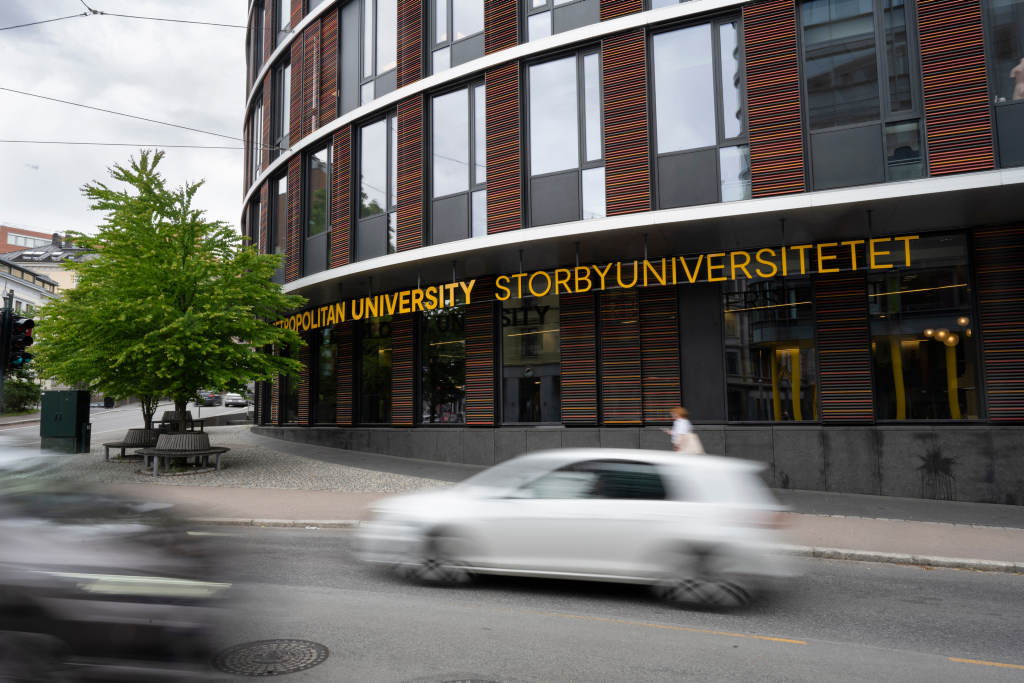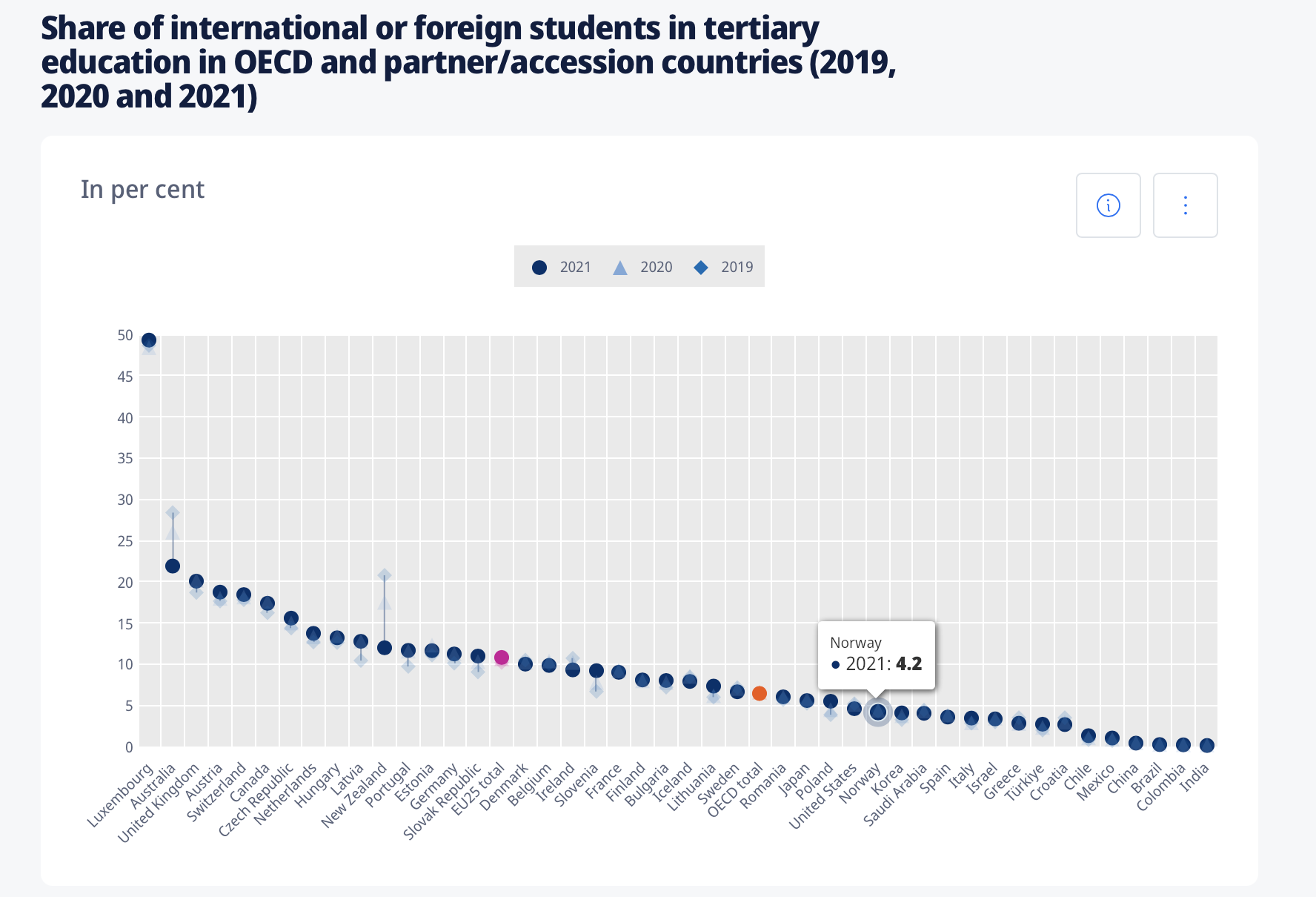
Nordic Labour Journal
OCT 23, 2024 | Text: Lars Bevanger, photo: OsloMet
The number of international students in Norway is falling dramatically. Fewer Norwegian students are going abroad and fewer international students are arriving. A loss for Norway, argue educational experts.
Frøya Skyrud is in her second year studying criminology at the Salford University in England. She is one of a shrinking number of Norwegian students who choose to travel abroad to pursue a degree in the UK – simply because it has become too expensive.
“Last year I got 375.000 kroner (€31.800) from the Norwegian State Educational Loan Fund. At the end of my first six months, I had paid half of my school fees and half of my rent, and I was left with 1,500 kroner (€127) to live on for the next four months,” she says. 
Frøya Skyrud will be left with huge student debts after her education in England. Photo: private
To make ends meet, she has worked and saved up money. Skyrud reckons she will be left with nearly one million kroner (€84.800) in debts when she graduates from Salford University – roughly double what her course would have cost her in Norway.
“It is really not nice to see so many choosing not to travel abroad to study because they can’t afford it. When you study abroad you become far more self-sufficient and you learn a lot about yourself. I also gain international competence because my course focuses on English and American justice systems,” says Skyrud.
Brexit, weak currency and cuts to grants
Much of the reason why studying in the UK has become so expensive is a record-weak Norwegian krone, which means the money from the Norwegian State Educational Loan Fund (Lånekassen) is insufficient.
After Brexit, British authorities have also introduced a visa for foreign students costing some €420 plus €565 for an extension after a certain period of time. The students must also now pay a fee to be able to use the National Health Service – currently costing €560.
“In the UK we have actually seen the number of Norwegian students cut in half over the past ten years,” says Øyvind Bryhn Pettersen, President of the Association of Norwegian Students Abroad ANSA.
In 2014 – 2015, there were 5,263 Norwegian students in the UK, and this year the number is down to 2,616. The number also fell in that same period in countries like Denmark – from 2,750 to 1,976 – and in the USA – from 2,077 to 1,509.
“Fees have become more expensive while the Norwegian government has made cuts to the grant portion of the tuition fee support,” says Bryhn Pettersen.
Good for Norwegian business
“It is disappointing that the government has cut the grant. This is directly contrary to the government’s own goal that half of Norwegian students should spend some time studying abroad.”
The ANSA President underlines that student mobility can create lasting connections across national borders, which can be of great value for Norway.
“Both because of the knowledge and cultural understanding the individual takes away from it, but it is also a boon for Norwegian business. Norway also needs new competencies outside of the oil and gas sector as part of the green transition.
“And it is naive to think that Norway can find the solutions to the great global challenges without an international network, and without Norwegians spending time abroad gathering knowledge from around the world,” argues Bryhn Pettersen.
Dramatic fall in international students to Norway
Higher education has in principle been free for all in Norway. But last autumn, the government introduced study fees for foreign students coming from countries outside of the EU and EEA.
“For us, it’s almost the end of the line, the number of students from countries that now have to pay has plummeted. This year we only have four paying foreign students,” says Silje Fekjær, Vice Rector for Education at the Oslo Metropolitan University, OsloMet.

Norway rates low on the number of international students attending Norwegian universities. In 2021 the number was 4.2 per cent. In the UK, the number was 20.1 per cent. Source: OECD
She is one of many in the Norwegian education sector who has voiced concern for what the falling numbers of foreign students will mean for higher education institutions and not least for other students.
Worried about the impact on study programmes
“What we are losing is the academic contribution this group of students has made to many of our study programmes. In both health, social sciences, and teacher education, we have had master’s programs with an international profile and significant collaboration with other countries,” Fekjær told the Nordic Labour Journal.
She points out that in several study programmes, the entire academic framework is based on having a diverse group of students from several countries.
“When you have a course built around examining international issues where students are expected to work actively together on understanding and development, we also need a varied international group of students.”
“Fair that foreign students pay their way”
When the Norwegian government introduced student fees last year, it argued it was only fair that foreign students had to pay their way as long as Norwegian students abroad had to do the same.
Other Nordic countries, like Sweden and Denmark, have already introduced similar student fees for international students.
Some education experts question the Norwegian government’s reasoning.
“It has long been Norwegian policy to promote internationalisation at home, meaning Norwegian students who do not go abroad should be exposed to an international element. For this, international students are of course key,” says Jannecke Wiers-Jenssen, Head of Research at the Nordic Institute for Studies in Innovation, Research and Education (NIFU).
A potential loss for Norwegian employers
She believes many Norwegian companies, that might be struggling to recruit the right special competencies, will lose out when fewer students choose to come to Norway.

Jannecke Wiers-Jenssen is Head of Research at the Nordic Institute for Studies in Innovation, Research and Education (NIFU). Photo: NIFU
“This can be a useful recruitment channel for the Norwegian labour market of people who know what they are letting themselves in for – as opposed to when you try to directly import IT engineers who do not know Norway well and might feel it is all quite a sudden change.
“We also know that many international students are studying subjects that few Norwegians chose to study,” says Wiers-Jenssen.
The OECD writes as part of the publication of its 2023 Education at a Glance Report something about what international students might bring to a globalised world:
“The movement of students across borders to pursue higher education in foreign countries significantly impacts individuals, institutions and societies worldwide. International student mobility can serve as a catalyst for academic excellence, cultural exchange, economic growth, and international understanding in an increasingly interconnected world.”
A dangerous development
“When international students disappear from Norwegian auditoriums, we also lose diversity and important perspectives, and discussions in the classroom become less rich, syas Selma Bratberg, President of the Norwegian Students’ and Academics’ International Assistance Fund (SAIH).
She believes this is a dangerous development also in a larger international context.
“It is worrying when education becomes more nationalistic and isolated. We live in a world where authoritarian powers are on the rise and universal human rights are under pressure.
“So it is more important than ever to make sure people can meet across national borders, exchange ideas, work together to find solutions to big challenges – both through student exchange and global research collaboration,” says Bratberg.